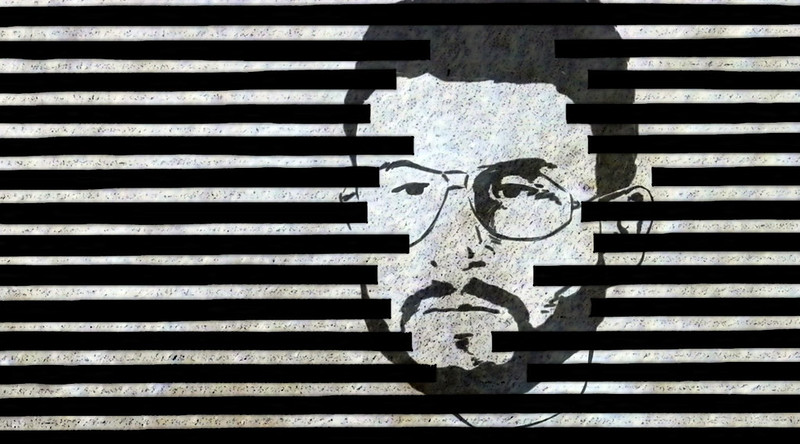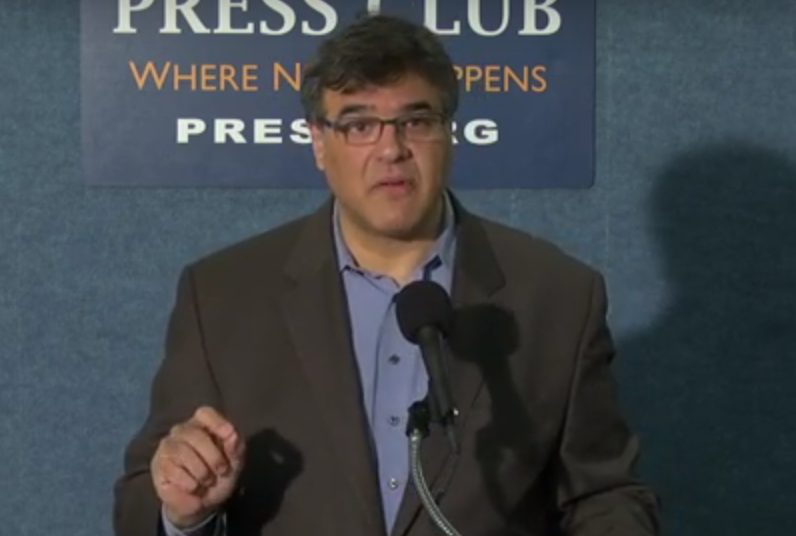Twenty Years in a Security State: CIA Goes into the Torture Business
WHISTLEBLOWING - SURVEILLANCE, 27 Sep 2021
Kevin Gosztola | The Dissenter – TRANSCEND Media Service
[Editor’s Note: To mark the 20th anniversary of the rise of the U.S. security state after the September 11th attacks, The Dissenter presents a retrospective on this transformation in policing and government. Each entry in the series, “Twenty Years in a Security State,” will connect with whistleblower stories where possible.]
20 Sep 2021 – CIA whistleblower John Kiriakou was asked in July 2002 if he wanted to be trained in “enhanced interrogation techniques.” He was one of 14 people invited to learn how to apply these torture methods who declined the offer.
“I had a moral and ethical problem with them. I had a legal problem with them. Besides being immoral and unethical, to me, they were clearly illegal. We have very clear laws and are signatories to international treaties that ban this kind of behavior,” Kiriakou declared on the “Primary Sources” podcast produced by Defending Rights and Dissent.
In 2007, according to Kiriakou, leaks about the torture program were increasing. The Red Cross, Human Rights Watch, and Amnesty International had each weighed in on what was known. He was afraid President George W. Bush’s administration would claim torture at the CIA was the result of a rogue officer and particularly point the finger at him.
Kiriakou did not want to be the fall guy. He went on ABC News and became the first CIA officer to publicly confirm that the CIA was torturing terrorism detainees. He said “torture was official U.S. government policy. It was not the result of a rogue, and that the policy had been personally approved by the president himself.”
Days after the September 11th attacks, the CIA still maintained standards for interrogations that went back decades.
The United States Senate Select Committee on Intelligence’s torture report summary recalled, “In January 1989, the CIA informed the [committee] that ‘inhumane physical or psychological techniques are counterproductive because they do not produce intelligence and will probably result in false answers.’” Testimony of the CIA deputy director of operations in 1988 denounced coercive interrogation techniques, stating, “[P]hysical abuse or other degrading treatment was rejected not only because it is wrong but because it has historically proven to be ineffective.”
Yet, in November 2001, the CIA researched “potential legal defenses” for employing methods that were viewed as “torture by foreign governments and a non-governmental organization.”
On November 26, according to the torture report summary, attorneys at the CIA’s Office of General Counsel circulated a memo that contained a potential “novel” legal defense: the “CIA could argue that the torture was necessary to prevent imminent, significant, physical harm to persons, where there is no other available means to prevent the harm.” It presumed states would be “very unwilling to call the U.S. to task for torture when it resulted in saving thousands of lives.”
Their actions reflected Vice President Dick Cheney’s infamous post-9/11 sentiment, which he expressed on “Meet The Press.” “We have to work the dark side, if you will. Spend time in the shadows of the intelligence world.”
The Torture Techniques That Were Approved
The torture techniques that Kiriakou declined to learn were developed by two contract psychologists named James Mitchell and Bruce Jessen. They previously were psychologists for the U.S. Air Force Survival, Evasion, Resistance, and Escape (SERE) school, which exposes soldiers to torture techniques they might experience if taken prisoner by a country that does not uphold the Geneva Conventions.
As the torture report summary noted, “Neither psychologist had experience as an interrogator, nor did either have specialized knowledge of al Qaida, a background in terrorism, or any relevant regional, cultural, or linguistic expertise.”
What Mitchell did have a background in was “learned helplessness.” He believed that by inducing a state of depression or passivity in a detainee they could be forced to cooperate and provide useful intelligence.
The torture techniques developed and approved were listed in a CIA inspector general report dated May 7, 2004.
An “attention grasp” involved grabbing a detainee with both hands. With one hand on each side of the collar, the interrogator would move the detainee in a “controlled and quick motion” toward the interrogator.
“Walling” consisted of the interrogator pulling the detainee forward and pushing them into a “flexible false wall so that his shoulder blades hit the wall.”
With open palms on each of the detainee’s face, interrogators could keep a detainee’s head immobile with a “facial hold.” They were also authorized to engage in “facial” or “insult slaps” of detainees’ cheeks between the earlobe and chin.
Another torture technique was “cramped confinement.” The detainee would be placed in a dark box, small or large. They could be put in a small box for two hours and a bigger box for up to 18 hours.
Interrogators were authorized to place “harmless insects” in the box of a detainee to play on a detainee’s phobia.
“Wall standing” involved a detainee stretching their arms in front until their fingers rested on a wall. The detainee would spread their feet shoulder width and support their weight without being allowed to reposition their hands or feet during the stress position.
Other stress positions were authorized, like putting the detainee on the floor with their legs “extends straight out in front of him with his arms raised above his head or kneeling on the floor while leaning back at a 45-degree angle.” Sleep deprivation could last up to 11 days.
But the harshest torture technique, and the last resort for interrogators, was supposed to be waterboarding.
A detainee was bound to a bench with their feet above their head. The head was immobilized. A cloth was placed over their mouth while water was poured. Airflow was restricted for “twenty to forty seconds” to create the “sensation of drowning and suffocation.”
Outside of the CIA inspector general’s report, the CIA’s Office of Medical Services had a list of methods for torture and abuse broken down into two categories—“standard” and “enhanced.”
Standard measures included shaving, stripping, diapering (up to 72 hours), hooding, isolation, white noise or loud music, continuous light or darkness, uncomfortably cool environment, dietary manipulation, shackling in an upright, sitting, or horizontal position, water dousing, and sleep deprivation (up to 72 hours).
The “enhanced” measures not in the inspector general report’s list were abdominal slaps and prolonged diapering.
The First CIA Detainee Subjected To The Torture Program
Abu Zubaydah, the first CIA detainee subject to “enhanced interrogation techniques,” was captured on March 28, 2002. Kiriakou led the raid in Pakistan and apprehended him. He guarded Zubaydah in the hospital after he received treatment for severe gunshot wounds. He helped load Zubaydah onto the aircraft that flew him to a black site prison in Thailand. But Kiriakou was not involved in Zubaydah’s interrogation.
As Kiriakou summarized on “Primary Sources,” the FBI interrogated Zubaydah before the CIA. They worked on establishing a rapport. “Here’s an orange. Here’s a cigarette. Would you like to write a letter to your mother?” All to get Zubaydah to open up, and it was working. However, the CIA believed they could obtain intelligence faster through torture.
The FBI team was removed from the black site, and Mitchell and Jessen, who were paid more than $80 million, took over.
On August 3, 2002, according to the Senate torture report summary, the CIA authorized torture against Zubaydah. He was interrogated on a 24-hour-per-day basis from August 4 to August 23. Only Mitchell and Jessen were supposed to have contact with Zubaydah.
The first day of his interrogation Zubaydah was subject to walling, put in a small and large box, and later waterboarded. Over a two-and-a-half-hour period, he “coughed, vomited, and had ‘involuntary spasms of the torso and extremities.’” Zubaydah maintained he could not answer interrogators’ questions about terrorist operations planned against the United States.
“He did vomit a couple of times during the waterboard with some beans and rice,” an email from OMS leadership noted. “It’s been 10 hours since he ate so this is surprising and disturbing. We plan to only feed Ensure for a while now.”
Zubaydah Should Remain ‘Incommunicado For The Rest Of His Life’
For 20 days, Zubaydah was put through an “aggressive phase of interrogation,” where he spent 11 days and two hours in a large coffin-size box. He was kept in a small box for 29 hours that was only little more than 2 feet wide, 2.5 feet long, and 2.5 feet high. “CIA interrogators told Abu Zubaydah that the only way he would leave the facility was in the coffin-shaped confinement box.”
Cables documented Zubaydah’s crying, begging, pleading, and whimpering. He kept telling interrogators he knew nothing about terrorists in the United States or current plots against the United States.
During one waterboarding session, Zubaydah had to be brought back from death by medical personnel. He expelled “copious amounts of liquids” after being “unresponsive with bubbles rising through his open full mouth.” Zubaydah was waterboarded a total of 83 times.
“The CIA instructed personnel that the interrogation of Abu Zubaydah would take ‘precedence’ over his medical care, resulting in the deterioration of a bullet wound Abu Zubaydah incurred during his capture,” the torture report summary further acknowledged.
On August 8, CIA personnel recorded how they were processing the brutality. “Several on the team profoundly affected…some to the point of tears and choking up.” The following day it was mentioned that one or two people on the team may seek a transfer if the interrogation continues.
“Especially in light of the planned psychological pressure techniques to be implemented, we need to get reasonable assurances that [Abu Zubaydah] will remain in isolation and incommunicado for the remainder of his life,” the interrogation team wrote to ALEC station, which was dedicated to hunting down Osama bin Laden and those allegedly responsible for 9/11.
ALEC station replied, “All major players are in concurrence that [Abu Zubaydah] should remain incommunicado for the remainder of his life.”
Zubaydah was detained at various black site prisons before he was finally brought to the Guantanamo Bay military prison, where he remains detained without charge or trial. It is widely accepted, including by Kiriakou, that he was not the high-ranking al Qaida figure they initially believed.
Gina Haspel, who served as CIA director under President Donald Trump, helped the CIA conceal evidence of Zubaydah’s torture by destroying tapes of his waterboarding sessions.
This had a huge influence on the Senate intelligence committee and fueled the decision to produce a study on the CIA’s torture program. And yet the committee still confirmed her to the position of CIA director.
Mitchell and Jessen were sued in October 2015 by the American Civil Liberties Union (ACLU) on behalf of two torture survivors and the family of Gul Rahman, who died from torture. A federal judge refused to dismiss the case, and the contractors agreed to a settlement.
The men were accused of water torture, forcing prisoners into boxes, and chaining them them into painful stress positions on the walls. Before settling, they invoked Nazi war criminals to defend themselves.
Citing a case involving Zyklon B, their attorneys argued the “‘owner and second-in-command of the firm were found guilty; [Joachim] Drosihn, the firm’s first gassing technician, was acquitted.’ Explaining this result, the court noted: The functions performed by Drosihn in his employment as a gassing technician were an integral part of the supply and use of the poison gas, but this alone could not render him liable for its criminal use, even if he was aware that his functions played such an important role in the transfer of gas.”
But Kiriakou told The Dissenter he believed Mitchell and Jessen should have known torture was illegal and their training would be used to “carry out an illegal program.” There was no similarity between this case and the Zyklon B case because they did the torture. “So they’re not just the suppliers of the Zyklon B. [They were] the deliverers of the Zyklon B.”
Mitchell and Jessen lied to CIA headquarters saying they waterboarded Zubaydah, and this is what he said. Zubaydah did not tell them anything, but they knew what the FBI had in their computer system, according to Kiriakou.
“The FBI computer system and the CIA computer system were not integrated. So FBI personnel could not read CIA cables, and CIA personnel could not read FBI cables,” Kiriakou recalled on “Primary Sources.”
“They took everything the FBI had reported on Abu Zubaydah, what he said, from the FBI interrogations. They put it into a CIA cable and said here’s what he said after we waterboarded him one time and they sent it in. And people were like, oh my god, it works. It actually works. We did it one time, and he gave us this wealth of intelligence. Well, none of that was true.”
The information was actually stolen from FBI Special Agent Ali Soufan. His interrogation without torture helped uncover the name of Khalid Sheikh Mohammed (who the CIA later detained and tortured).
‘Torture Is A Slippery Slope’
Aside from Zubaydah, the torture report summary mentions five CIA detainees who were subject to “rectal feeding without documented medical necessity.” There were detainees put in ice water “baths.” One detainee was told “we can never let the world know what I have done to you.” So he would be deprived due process or his day in court to defend himself against allegations.
There were at least two instances where the CIA used torture, “despite warnings from CIA medical personnel that the techniques could exacerbate physical injuries. CIA medical personnel treated at least one detainee for swelling in order to allow the continued use of standing sleep deprivation.”
Physicians for Human Rights brought attention to this aspect of the torture program, documenting how medical professionals at the CIA participated in “human subjects research” that constituted a crime against humanity.
Kiriakou and Joseph Hickman, a whistleblower and former Army staff sergeant at Guantanamo Bay, co-authored a book on Zubaydah called The Convenient Terrorist. It includes a key exchange Kiriakou had around the time he was invited to become a professional torturer.
At the end of July 2002, Kiriakou informed “a very senior CIA officer” that an officer with the CIA’s Counterterrorism Center had asked if he wanted to be trained in “enhanced interrogation techniques.” The senior officer told him, “First, let’s call it what it is. It’s torture.”
“They can use any euphemism they want, but it’s still torture. And torture is a slippery slope. Eventually, somebody is going to go overboard, and they’re going to kill a prisoner. When that happens, there’s going to be a congressional investigation. Then there’s going to be a Justice Department investigation.”
“And in the end somebody’s going to go to prison. Do you want to go to prison?” the senior officer asked.
Kiriakou went back to the CTC officer and told him, “This is a torture program. I don’t want to be associated with it.”
No one was ever prosecuted by the Justice Department for their involvement in torture. Not a single person was sentenced to prison for torturing detainees. President Barack Obama insisted on moving forward instead of looking backward, and torture effectively was decriminalized.
Ironically, Kiriakou, a whistleblower who refused to associate himself with the torture program, went to prison. John Brennan, who defended the torture program and later became CIA director under Obama, requested the Justice Department charge him with “espionage.”
Kiriakou was convicted of a felony and spent about two years in a federal prison in Loretto, Pennsylvania.
___________________________________________
Kevin Gosztola is managing editor of Shadowproof, host of the “Dissenter Weekly,” co-host of the podcast “Unauthorized Disclosure,” and member of Society of Professional Journalists (SPJ)
Tags: Abu Ghraib, Bruce Jessen, CIA, Enhanced Interrogation, Guantanamo, History, Human Rights, Invasion, Iraq, James Mitchell, Michael Chertoff, NATO, Occupation, Pentagon, Rendition, State Terrorism, Torture, US Military, USA, Violence, War, Whistleblowing
DISCLAIMER: The statements, views and opinions expressed in pieces republished here are solely those of the authors and do not necessarily represent those of TMS. In accordance with title 17 U.S.C. section 107, this material is distributed without profit to those who have expressed a prior interest in receiving the included information for research and educational purposes. TMS has no affiliation whatsoever with the originator of this article nor is TMS endorsed or sponsored by the originator. “GO TO ORIGINAL” links are provided as a convenience to our readers and allow for verification of authenticity. However, as originating pages are often updated by their originating host sites, the versions posted may not match the versions our readers view when clicking the “GO TO ORIGINAL” links. This site contains copyrighted material the use of which has not always been specifically authorized by the copyright owner. We are making such material available in our efforts to advance understanding of environmental, political, human rights, economic, democracy, scientific, and social justice issues, etc. We believe this constitutes a ‘fair use’ of any such copyrighted material as provided for in section 107 of the US Copyright Law. In accordance with Title 17 U.S.C. Section 107, the material on this site is distributed without profit to those who have expressed a prior interest in receiving the included information for research and educational purposes. For more information go to: http://www.law.cornell.edu/uscode/17/107.shtml. If you wish to use copyrighted material from this site for purposes of your own that go beyond ‘fair use’, you must obtain permission from the copyright owner.
Read more
Click here to go to the current weekly digest or pick another article:
WHISTLEBLOWING - SURVEILLANCE:



